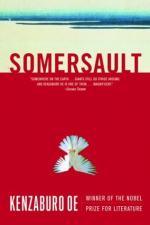|
This section contains 803 words (approx. 3 pages at 300 words per page) |

|
SOURCE: Rubin, Merle. “Strange Beauty amid Horror, Grief.” Christian Science Monitor 87, no. 115 (10 May 1995): 14.
In the following essay, Rubin notes that, although Ōe's writing explores uniquely Japanese issues and themes, the virtuosity of Ōe's prose has allowed his works to take “their place in the global pantheon.”
One of the leading lights of Japanese postwar literature, Kenzaburo Oe was awarded the Nobel Prize in 1994, just as he was announcing his intention to write no more fiction. His novels and stories, as he explained, had been driven by his desire to speak on behalf of his handicapped son who, after years of struggle, had finally found his own means of self-expression through the beautiful music he taught himself to compose.
Giving up fiction, however, does not necessarily entail giving up all forms of writing. Oe's creativity and his deep concern for his country's future, poignantly expressed in his Nobel acceptance...
|
This section contains 803 words (approx. 3 pages at 300 words per page) |

|


